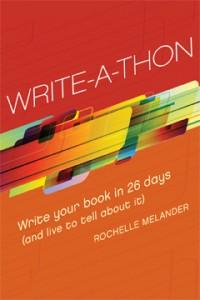NaNoWriMo: Write What You Know
 Today’s post is an excerpt from my new book, Write-A-Thon: Write Your Book in 26 Days (And Live to Tell About It) called Write What You Know.
Today’s post is an excerpt from my new book, Write-A-Thon: Write Your Book in 26 Days (And Live to Tell About It) called Write What You Know.
If you are going to write you must become aware of this richness in you and come to believe in it and know it is there so that you can write opulently and with self-trust. —Brenda Ueland
Many writers have abandoned a day of writing or even a project because they get stuck on a tricky part. You do not know how to explain rocket science to a layperson. You’re not sure how to put together a diagram that would sufficiently explain the progression of . . . well . . . of whatever it is you are writing about. Maybe you cannot figure out how the protagonist discovers that his girlfriend is cheating. I stopped working on my memoir for two years because I could not figure out how to structure the book.
When sports psychologist Caroline Silby wrote her first book, Games Girls Play: Understanding and Guiding Young Female Athletes, she got through the difficult parts by setting those aside for a time and writing what she knew. It’s not a bad idea. When I started to work on my memoir again, I decided to set aside the idea of a perfect structure and simply write the book scene by scene, starting with the scenes I knew how to write.
If you’re stuck, start by creating a page in your manuscript for every chunk in your table of contents or every scene in your novel’s outline. You might just have a title or a few notes about setting and action on each page, but that is okay.
Review your table of contents or your scene outline. Put a check mark next to every piece you think you could write in your sleep. Meaning, check the topics that you know a lot about or the novel’s scenes that are well developed in your head. Go to the pages that you created for each of these topics or scenes and write those.
When you’re done with writing what you really know well, the stuff you could write about while walking backwards and chewing gum, it’s time to write what you know about the chunks you don’t know as well. Look at what’s left on your topic list or scene outline. What do you kind of know something about? Mark those items.
Go to the pages with the topic or scene title on them and list what you do know about each chunk. You might only know where the scene takes place or who is in it—that’s enough. Write it down. Add what you need to know to write the chapter—or perhaps what you need to think about. After a day or so off, you will be able to go back to these jottings and put together the chunk.
Once you have written about everything you know really well and everything you know kind of well, you will be left with the topics or scenes you think you know nothing about. Yikes! Wait, don’t worry. This really isn’t a problem. Remember: this is your book. Your area of expertise. Your characters. Your story. You must know something about even the things you think you know nothing about or it would not be part of your book. So, my dear reader, go to those pages in your manuscript and write down everything you think you know about the topics or scenes you don’t think you know anything about.
Did you do it?
Apply the same process you applied before to these chapters: give it a few days and get back to it. Chances are, with time, you will be able to write those chapters as well.
When novelist Janet Fitch wrote White Oleander, she wrote it out of order. She’d write any scene that had energy for her, print it out, and throw it in a box. When she was done, she put them in order. When I get stuck, I pretend I am writing to a client with a specific problem. When I start solving her problem, I forget about my problem with writer’s block, and soon I am typing away!
Next time you get blocked on a chapter or even a paragraph, ask yourself: “So, what DO I know?” Write what you know (even if it is simply a description of the character’s socks) until you stop feeling blocked.
You will be surprised at how much wisdom you have buried beneath all that useless information you carry around with you. You are a virtual treasure trove of valuable information and ideas.









Thank you very much for the quote at the end – it spoke to me where I am. I have now shared on Yammer/Twitter/Facebook
Thanks, Lynn!